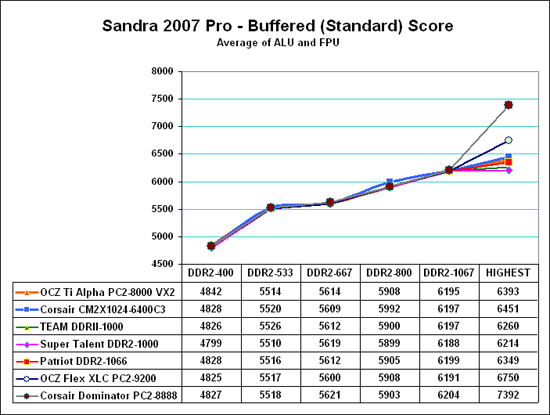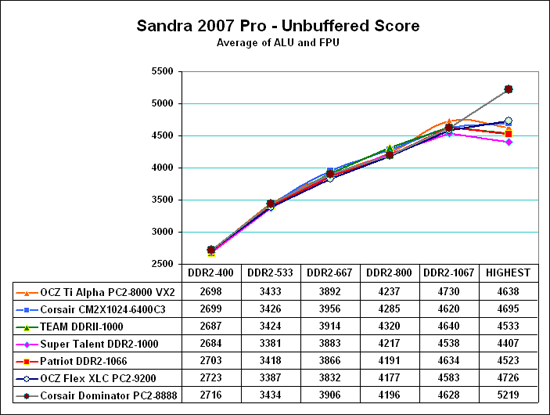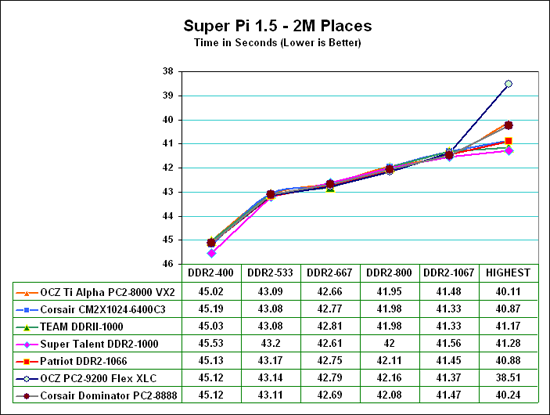Corsair Dominator DDR2-1111: Dual-Path Cooling Pushes Performance
by Wesley Fink on January 1, 2007 5:15 AM EST- Posted in
- Memory
Memory Bandwidth Scaling
Memory bandwidth normally improves with increases in memory speed and reductions in memory timings. This is best illustrated using Performance Scaling charts.
Since the results for high-end memory were so close at all tested speeds, the scale range was reduced to better show the small differences in these memory benchmark results. Please keep this in mind when viewing the charts, since a normal zero scale would make performance differences appear much smaller than these expanded scale charts. Test values for each memory at each speed are included below each chart for reference.
To evaluate memory bandwidth SiSoft Sandra 2007 Professional was used to evaluate standard Buffered performance and Unbuffered memory bandwidth.

The most widely reported Sandra score is the Standard or Buffered memory score. This benchmark takes into account the buffering schemes like MMX, SSE, SSE2, SSE3, and other buffering tools that are used to improve memory performance. The Buffered benchmark does not correlate well with real performance differences in games, so our memory bandwidth tests have always included an Unbuffered Sandra memory score. The Unbuffered result turns off the buffering schemes, and we have found the differences in unbuffered results correlate well with real-world performance differences.

In both Buffered and Unbuffered tests Corsair Dominator performance curves mirror the best memory tested to DDR2-1066. While the differences are extremely small, Dominator more often than not is the fastest memory we have tested at any given speed. This is what would be expected since Dominator is based on the same core memory chips as the other tested memories. Memory bandwidth increases dramatically at the top in buffered bandwidth (standard test) on the 680i. This is mostly a result of the much higher overclock in memory that could be achieved with the Corsair compared to other Micron D-based memory. Unbuffered results also increase at the top speed, but not as dramatically as buffered results.
We also compared results with Version 1.5 of Super Pi - comparing the time to calculate two million places of Pi at the different memory speeds. This benchmark measures pure number crunching.

Super Pi results continue to improve to the highest speed that could be reached with stability with Corsair Dominator and other tested memories. What also stands out is how close the results with all the memories really are from DDR2-400 to DDR2-1066. This is mainly a reflection of the fact that compared memories are based on the same base Micron memory chips. At the highest speed Corsair Dominator and OCZ Flex XLC pull away from the pack with the record overclocks. The real difference between top overclock Super Pi results and stock DDR2-1067 results is very close. This shows the impact of CPU speed on calculation performance is much greater than the impact of memory speed increases.
Memory bandwidth normally improves with increases in memory speed and reductions in memory timings. This is best illustrated using Performance Scaling charts.
Since the results for high-end memory were so close at all tested speeds, the scale range was reduced to better show the small differences in these memory benchmark results. Please keep this in mind when viewing the charts, since a normal zero scale would make performance differences appear much smaller than these expanded scale charts. Test values for each memory at each speed are included below each chart for reference.
To evaluate memory bandwidth SiSoft Sandra 2007 Professional was used to evaluate standard Buffered performance and Unbuffered memory bandwidth.

The most widely reported Sandra score is the Standard or Buffered memory score. This benchmark takes into account the buffering schemes like MMX, SSE, SSE2, SSE3, and other buffering tools that are used to improve memory performance. The Buffered benchmark does not correlate well with real performance differences in games, so our memory bandwidth tests have always included an Unbuffered Sandra memory score. The Unbuffered result turns off the buffering schemes, and we have found the differences in unbuffered results correlate well with real-world performance differences.

In both Buffered and Unbuffered tests Corsair Dominator performance curves mirror the best memory tested to DDR2-1066. While the differences are extremely small, Dominator more often than not is the fastest memory we have tested at any given speed. This is what would be expected since Dominator is based on the same core memory chips as the other tested memories. Memory bandwidth increases dramatically at the top in buffered bandwidth (standard test) on the 680i. This is mostly a result of the much higher overclock in memory that could be achieved with the Corsair compared to other Micron D-based memory. Unbuffered results also increase at the top speed, but not as dramatically as buffered results.
We also compared results with Version 1.5 of Super Pi - comparing the time to calculate two million places of Pi at the different memory speeds. This benchmark measures pure number crunching.

Super Pi results continue to improve to the highest speed that could be reached with stability with Corsair Dominator and other tested memories. What also stands out is how close the results with all the memories really are from DDR2-400 to DDR2-1066. This is mainly a reflection of the fact that compared memories are based on the same base Micron memory chips. At the highest speed Corsair Dominator and OCZ Flex XLC pull away from the pack with the record overclocks. The real difference between top overclock Super Pi results and stock DDR2-1067 results is very close. This shows the impact of CPU speed on calculation performance is much greater than the impact of memory speed increases.










14 Comments
View All Comments
anandtech02148 - Tuesday, January 2, 2007 - link
let say a dual ddr2 800mhz occupied 2 slotand the other 2 slot is occupied by 533mhz ddr2
although they operate at different voltage, will it work?
what am i to do with older memory modules when all these new
1111mhz and newer models come out
Wesley Fink - Wednesday, January 3, 2007 - link
Different grades of memory can be on the board, but the channels can not be individually set. Therefore the memory has to be run at the speed of the slowest modules. However, some 533 can run DDR2-800 and most run at least 667.anandtech02148 - Monday, January 1, 2007 - link
Cheers to Anandtech for using a 520psu. hooorayy.. finally we're testing something at a sane level.
600buxs for memory, one of the reason why Intel got out of memory business to focus on Cpu
in 1980s.
2.4v to operate, are we reaching 12v soon for running memory modules?
in the meantime i'm still dreaming for that 2gig at 100buxs range. and i was a fan of Rambus RAm until this ddr cartels took over.
daos - Monday, January 1, 2007 - link
I recently purchased some Dominator PC6400C4D to replace my old OCZ PC6400 Platinum. I can honestly say that the heatsinks make a huge difference in overall temps of the DIMMS. Either the OCZ ran extremely hot at default voltage or the Dominators are insanely efficent at keeping the memory cool.I run these at 2.4v 3-3-4-9 DDR2800Mhz and they are cool to the touch. I still cannot believe how cool these heatsinks keep the memory. At first I was hesitant to raise the voltage to 2.4v but after seeing how cool they run I wish my P5WDH board allowed for higher memory voltages!
Guys/Gals, the heatsinks really do work and I am a living example of it. I have always been the one to instantly rip the spreaders off of memory in the past but these really work.
MadAd - Monday, January 1, 2007 - link
Not so long ago ram worked perfectly fine without heatspreaders at all, calculations at the time showed that ram was no-where near needing them now its hard to get anything but value ram without them. For a few coinsworth of metal they have engineered lots of pretty colors and shapes to dazzle us with but do we really need it?IMO instead of a pro-forma memory review, you have an opportunity to spice it up a bit with the angle of either supporting this new fad, or cut through the spin, with some measured data. Simply take the ugly things off and benchmark it again. See if it still hits the same highs and still retains its timings with no heatspreader.
Wesley Fink - Monday, January 1, 2007 - link
A very good idea. The only problem is the inner heatsinks are heat merged to the PCB, and the outer heatsinks use a thermal epoxy for mounting to the memory chips. Unlike the old days, removing a heatspreader is now often fatal to memory. The surface mount memory chips are easily pulled off, even if you use extreme care, in trying to remove the outer heatspreaders. Removing the inner ones could destroy the PCB.We could test this if the memory makers would supply the memory without heatsinks. The question then is why would they want to?
I can tell you from past testing that fan cooling the memory definitely extends overclocking to higher levels. However, removing heatsinks made no difference at all in OC on DDR with simpler sinks. This setup by Corsair is quite a bit more sophisticated than the colored metal covers and it may make some real difference in performance.
MadAd - Thursday, January 11, 2007 - link
Ok point accepted that it may be hard to render them testable if epoxy is used but dont you love a challenge? :lol:Honestly, its starting to get serious now with these http://www.dailytech.com/article.aspx?newsid=5662">http://www.dailytech.com/article.aspx?newsid=5662
As you know yourself fan cooling is something applied whatever the form they come in, ok so you could analyse how efficient each method is but the big question is still whether its all just hype or not. I think hype.
cmdrdredd - Monday, January 1, 2007 - link
Team Extreme memory never comes with heatspreaders, and they make memory that can go to DDR2-1200 with the right setup. What does this tell you?customcoms - Monday, January 1, 2007 - link
Wes, I am sorry, but if I'm reading the same benchmarks as you are, of the three games you tested, the OCZ is still the fastest memory (granted, Quake 4 is within margin of error) period, around 1-2 fps faster than the corsair. Why you say the corsair is faster when the benchmarks speak otherwise (the tighter timings+higher speed and the higher raw speed of the corsair is the only thing I see better than the OCZ).
Basically, in real world applications (i.e games, which are what 95+% of the market buying these kits are doing with their machines), the OCZ is faster, according to YOUR OWN benchmarks. You also give it the edge on the 975X platform. Hence, I would say it is the better ram (plus it has the option for water cooling). Doesn't really matter, as I won't be spending that kind of money on ram EVER-better to buy an 8800GTX etc.
Wesley Fink - Monday, January 1, 2007 - link
When you also include results on the nVidia 680i the Corsair Dominator is faster overall. On the 975x, which is the only thing included in the graph results, the OCZ Flex XLC is faster. Individual timings are also slightly faster at DDR2 1067 and DDR2 667 on the Corsair.OCZ Flex XLC and Corsair Dominator PC@-8888 are both at the top of our benchmarking and either would be a great enthusiast choice. The Corsair pushes the 680i slightly faster and therefore is the fastest memory we have tested to date.